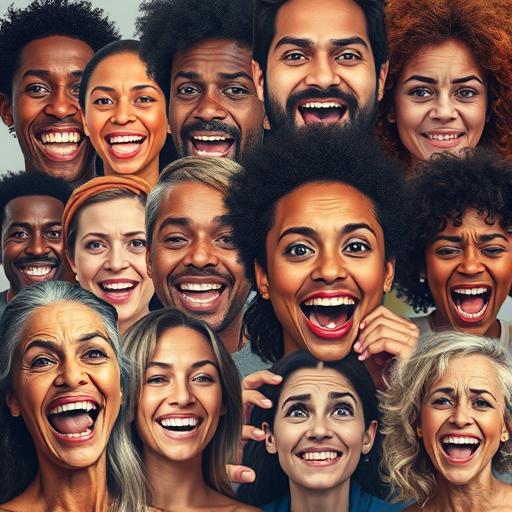Unspoken Power: The Truth Behind Facial Expressions

Unspoken Power: The Truth Behind Facial Expressions
Unspoken Power: The Truth Behind Facial Expressions

Understanding the Language of Facial Expressions
Facial expressions play a crucial role in human communication, often conveying more than words ever could. Our face is an incredible tool that can express a myriad of emotions—joy, sadness, anger, surprise, and even fear—without a single word being spoken. According to research, non-verbal communication accounts for roughly 93% of emotional expression, with facial expressions being a significant component of this. When we meet someone, our brains are wired to pick up on these subtle hints, giving us insights into their emotional state and intentions. This means that every time you smile, frown, or raise an eyebrow, you are sending powerful signals to those around you. The ability to interpret and consciously utilize facial expressions can help you navigate social situations, foster positive relationships, and even enhance your leadership skills. 🎯💪
Moreover, understanding the facial expressions of others can lead to improved empathy and emotional intelligence. Recognizing the subtle cues in someone's face allows us to respond appropriately, making our interactions more genuine. Imagine engaging with someone who seems upset; if you can discern this through their facial expressions, you might offer support or ask how they are doing. By decoding the unspoken language of emotions, you create an environment of trust and compassion, fostering deeper connections.

The Science Behind Facial Expressions
While it may seem like a natural instinct to interpret facial expressions, it is, in fact, a complex blend of biology and psychology. Charles Darwin's studies on emotions suggested that expressions evolved as adaptive responses to social situations. The facial muscles that help us convey expressions are deeply interwoven with our nervous system. For instance, when you feel genuine happiness, the zygomatic muscles lift your cheeks, creating a smile that not only alters your face but also sends signals to your brain, boosting your mood. 🚀
Moreover, scientists have identified specific expressions linked to universal emotions; this means that facial expressions can convey similar meanings across diverse cultures. Research by Paul Ekman, a renowned psychologist, revealed that facial expressions such as happiness, sadness, and anger share common traits worldwide. This universality highlights the potential of facial expressions as a bridge for effective communication, even in cross-cultural interactions. When you prioritize reading and mastering this unspoken aspect of communication, you enhance your ability to connect with others, overcoming barriers created by language and cultural differences.

"The most important thing in communication is hearing what isn't said." – Peter Drucker 🌟
Mastering Your Own Facial Expressions
Being aware of your own facial expressions is just as vital as understanding those of others. The way you present yourself can significantly influence how people perceive you. Are you aware that your facial expressions can alter the reception of your message? If you're delivering a presentation or having a difficult conversation, your expressions can either reinforce or contradict your words. A mixed message, where your words suggest you are confident but your face shows uncertainty, can lead to distrust or confusion.
To master your facial expressions, you can practice being mindful and intentional. Start by becoming aware of the feelings you are experiencing and how they reflect on your face. Try practicing in front of a mirror, or record yourself speaking on a topic, focusing on your facial expressions in addition to your words. With each practice session, identify whether your facial expressions align with your intentions. When you can harmonize your expressions with your desired message, you create a powerful tool for persuasion and connection. 🔥

How-To: Master Your Facial Expressions
- Practice mindfulness to become aware of your emotions and their expressions.
- Use a mirror to rehearse your facial expressions while communicating.
- Record and review conversations to see how your expressions align with your message.
- Seek feedback from trusted friends or colleagues about your nonverbal cues.
- Experiment with different emotions to broaden your range of expressions and learn flexibility.
Enhancing Emotional Intelligence Through Facial Expressions
Emotional intelligence (EI) is not merely about recognizing your emotions; it also encompasses understanding others' emotions. By honing your ability to read facial expressions, you can elevate your emotional intelligence significantly. High EI enables you to navigate interpersonal relationships more effectively, whether in the workplace or personal life. As you become more attuned to the emotions of others, you can respond more appropriately and empathetically, enhancing relationships and social dynamics.
In professional environments, being emotionally intelligent means practicing active listening, responding to body language, and adjusting your communication style based on somatic cues. For instance, if you notice a colleague is frowning during a meeting, you may choose to pause and check in with them. This not only demonstrates concern but also encourages a supportive atmosphere where people feel comfortable sharing their thoughts. Developing this skill not only empowers you as a communicator but also positions you as a leader who values collaboration and empathy.
The Impact of Facial Expressions on Personal and Professional Success
Several studies have illustrated the significant impact facial expressions can have on personal and professional success. An influential study conducted by researchers at the University of California, Los Angeles, found that individuals with expressive faces are often perceived as more trustworthy, approachable, and competent. In a professional setting, this can translate into more opportunities, collaborations, and relationships that help propel your career forward.
In your personal life, effective facial expressions can strengthen bonds with friends and family. Showing warmth and enthusiasm through your expressions makes you more relatable and approachable. This fosters an inviting atmosphere, allowing others to feel welcome to share ideas or raise concerns. The power of your facial expressions extends beyond mere greetings; it plays an essential role in maintaining and deepening relationships.

Additionally, when you leverage your facial expressions in networking and social situations, you can engage others more effectively. For instance, a genuine smile when meeting someone instantly communicates friendliness and openness, making it easier to strike up a conversation. Being aware of your face as a communication tool gives you an edge in any interaction, creating memorable connections that can blossom into both personal friendships and professional alliances.
"Your body language may be more important than your words." – Judith Orloff 🚀
Conclusion
The unspoken power of facial expressions carries immense significance in our daily lives, influencing how we communicate and connect with those around us. By understanding the intricacies of facial expressions, both in ourselves and in others, we unlock not only the potential for greater emotional intelligence but also the ability to navigate life with authenticity and confidence.
Investing in the mastery of your own expressions and learning to read the emotions of others can transform your personal and professional interactions. Whether you are striving for success in your career or nurturing relationships with friends and family, remember that your facial expressions serve as your silent yet powerful allies. Embrace this profound language of emotion, and let it guide you toward deeper connections and a more fulfilling life. 🌟
Ready to Elevate Your Communication?
Unlock your full potential by mastering the unspoken language of the face. Take the next step to become more confident, empathetic, and influential! 💪
